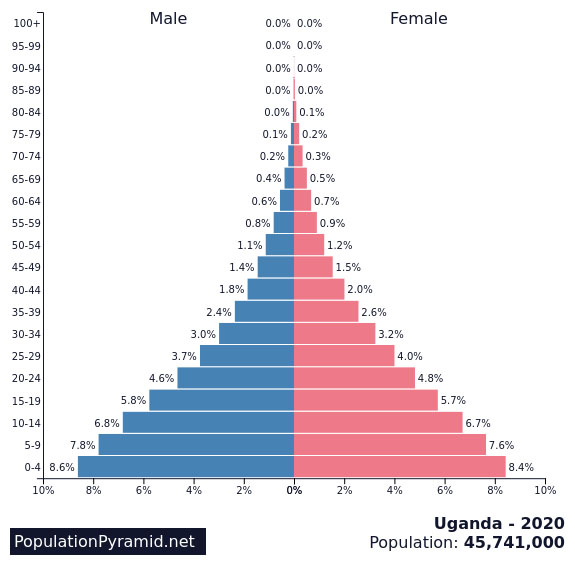
YOUNG MEN DYING: The puzzle of why numbers decline when they turn 20
Kampala, Uganda | RONALD MUSOKE | Uganda’s demographic projections are interesting; particularly on population distribution by gender between ages 15-24 years.
Demographers The Independent has talked to say it is a well-known fact that women in Uganda have always outnumbered men. Yet that reality does not begin at birth.
In fact, there are more male children born at birth than females. “The ratio is 104:100,” says Tim Mugyera, a demographic expert at National Population Council- Uganda.
Yet, according to the Uganda Bureau of Statistics (UBOS), the agency in charge of official national numbers, the mid-year population projections released on Oct.09 which put the country’s population at 44.2 million have 22,451,000 women (51%) and 21,761,800 men (49%). This implies that there are 97 men for every 100 women in the country or three men fewer for every 100 women.
Up to this point, Uganda’s numbers appear to match the general trend of more boys being born than girls and girls or women somehow overtaking the boys or men later in life.
Dr. Charles Lwanga, a lecturer of population studies at the School of Statistics in Makerere University, attributes the flip in gender of majority population to how males and females cope with life’s challenges.
“As the babies grow, more females tend to survive life’s vagaries than males,” he says.

Dr. Frederick Makumbi, an associate professor in the Department of Epidemiology and Biostatistics at the School of Public Health in Makerere University says it is actually not intriguing; especially if one studies the demographic dynamics around the world.
Toshiko Kaneda, the technical director for demographic research at the Washington DC-based Population Reference Bureau (PRB) also told The Independent on Oct. 12 that the sex ratio at birth is typically about 105 around the world, meaning that there are about 105 male babies per 100 female babies.
Numbers from the US-based Pew Research Centre also show that at birth and without any human intervention, boys slightly outnumber girls, at a rate of around 105 boys per 100 girls, with male births ranging from 103 to 107 per 100 girls in most countries.
Kaneda told The Independent that the higher number of boys born could be to “make up” for the higher mortality among males than females at all ages. She, however, hastily adds that the decline in sex ratio does not occur rapidly; rather it occurs more gradually across ages.
“Sex ratio continues to decline into older ages. This is typical around the world. Where sex ratio does not decline is actually abnormal, as in some countries, mostly in Asia, where son preferences have traditionally led to practices that affected sex ratios at births among infants, such as sex-selected abortions or infanticides,” she told The Independent in an email.
Uganda’s numbers
Based on Toshiko Kaneda’s explanation of a gradual shift, Uganda’s numbers appear unusual as the shift occurs rather dramatically from age 15-19 to age 20-24.
As of June, this year, UBOS noted that there are more male children aged between 0-15 years compared to female children in the same age bracket yet, when these children grow into young adults (20-24 years), the women start outnumbering their male counterparts.
The population of Ugandans aged 15-19 is 5,208,900 with 2,638,800 being boys while 2,570,100 are girls. This is typical: Boys outnumber girls by 68,700. But then something dramatic appears to happen. The number of male children begins to fall. As these children transition into young men and women and enter the age bracket of 20-24, the women suddenly become more than men.

According to UBOS numbers, the population of Ugandans aged 20-24 is 4,433,600. Of these, 2,192, 100 are males and 2,241,500 females. Now, suddenly, there are 49,400 more women than men.
The big question is why the sudden shift? What exactly happens to the boys as they transition into adulthood? Could it be that more young men begin dying off at this point compared to their female counterparts? Is this a cause for concern for Uganda’s population and development experts?
When The Independent asked several experts whether they find this phenomenon surprising, many said it is actually not shocking.
But is it not?
Life happens
Dr Charles Lwanga from the School of Statistics at Makerere University told The Independent that if one wants to understand what happens to Uganda’s boy child when they turn 20, one has to look into the issue of genetics as well as the environment in which they grow.
Mugyera of the National Population Council also told The Independent that the reason the sex ratio of boys to girls gradually reduces is because boys die off in significantly higher numbers than girls. He says this is the same in most parts of the world due to biological and genetic sex differences. He says boys are more biologically vulnerable to premature death and disease.
Still, why exactly do women in Uganda begin outnumbering men at the age of 20? What is so special about this particular age group?
Hellen Namirembe Nviiri, the Director, Population and Social Statistics at UBOS says there is no doubt that many men in Uganda succumb to the vagaries of life at a relatively young age. “Life happens and the number for females tends to stabilize and even overtakes that of males,” she told The Independent.
Judith Mutabazi, the Acting Manager for Population and Social Sector Planning at the National Planning Authority (NPA) also told The Independent on Oct.18 that as the young men enter into the working age group, they are exposed to all sorts of occupational health hazards.
Nviiri says the age group in question (20-24) is where you find young men begin founding families. As responsibilities mount, they begin taking on riskier work; they are the ones you are most likely to see riding Bodabodas or motorcycle taxis—a venture which kills many people every year.
Her theory appears vindicated by the annual road traffic reports which show more males among fatalities registered on Uganda’s roads. According to the Directorate of Traffic and Road Safety in the Uganda Police, over the last five years, at least 3,500 people have perished on Uganda’s roads every year while close to 10,000 have escaped with life-altering injuries.
And in each of those years, it is young men who have been the most affected. In 2020, for example, the police recorded 3,663 deaths on Ugandan roads and about 80% or 2,945 of the fatalities were men. Those who died that year and were below 18 years old were 382 boys compared to 246 girls. But those aged 18-24 were 470 men and 66 women.

Johnstone Galande, a senior statistician at UBOS also told The Independent on Oct.18 that as both the girls and boys progress in life, the boys tend to be more adventurous than girls. There is also the affinity to have money which starts quite early for boys than the girls.
“The risks the boys take later in life eventually get them into accidents and diseases. The boys also tend to have more sexual partners than the girls. All these expose the boys to more venereal diseases when compared to girls.”
Prof. Makumbi re-echoes the other challenge Ugandan men tend to struggle with: a poor health seeking behavior, especially for HIV/AIDS and TB infections.
Issue of concern
Still, Dr. John Ssekamatte-Ssebuliba, a consultant in the Department of Population and Social Sector Planning at the National Planning Authority (NPA) told The Independent on Oct.17 that this is an issue that has been of concern to Uganda’s demographers over the last three censuses (2014, 2002 and 1991).
“Historically, when you study Uganda’s demographic model, the sexual ratio at birth used to favour boys more than girls. So this (current) picture is not surprising,” he said. However, he notes that it is possible Uganda’s census enumerators could be finding a challenge counting men.
“One of the problems could be an undercount of men because in a normal population, you would expect men in the 20-35 age groups to be more than women because of Uganda’s high maternal mortality rate,” he says.
He rules out the suggestion that it is all because more men are dying off after age 20 years. He says a decline in population can be explained by both deaths and migration. “It is also possible that more men could be migrating out of Uganda than women,” he says.

The migration theory is also supported by Prof. Makumbi at the Department of Epidemiology and Biostatistics at the School of Public Health in Makerere University.
“When you go back to your village, who are you most likely to be told left the village and moved elsewhere? More men than women will have migrated,” Prof Makumbi told The Independent.
Going forward, it appears most local population and development experts suggest that there is nothing that can be done about the sex ratio difference in Uganda that continues to place women on the front foot.
Some say this is simply the natural progression of life. They suggest that women will always be more than men because of biological and genetic sex differences.
But Judith Mutabazi at NPA says it is high time Uganda’s population and development experts investigated and got to the bottom of the problem of why men start disappearing when they turn 20.
“There are many reasons why Ugandans die in their prime but is it because of occupational hazards or communicable diseases?” she wonders.
Mutabazi says unless experts find out the truth, the country will probably continue grappling with the challenge of high fertility rates since children are still perceived as social security in Uganda.
Mutabazi told The Independent that the fact that many people, especially men, die so early compels some parents to produce as many as possible with the hope that a few will make it into adulthood and support their elderly parents.
For Dr. Ssebuliba, some of the answers to Mutabazi’s concerns will probably be answered shortly after next year’s national population census. He says population and development experts will keenly look at the age and gender structure of the country’s population.
****
 The Independent Uganda: You get the Truth we Pay the Price
The Independent Uganda: You get the Truth we Pay the Price


